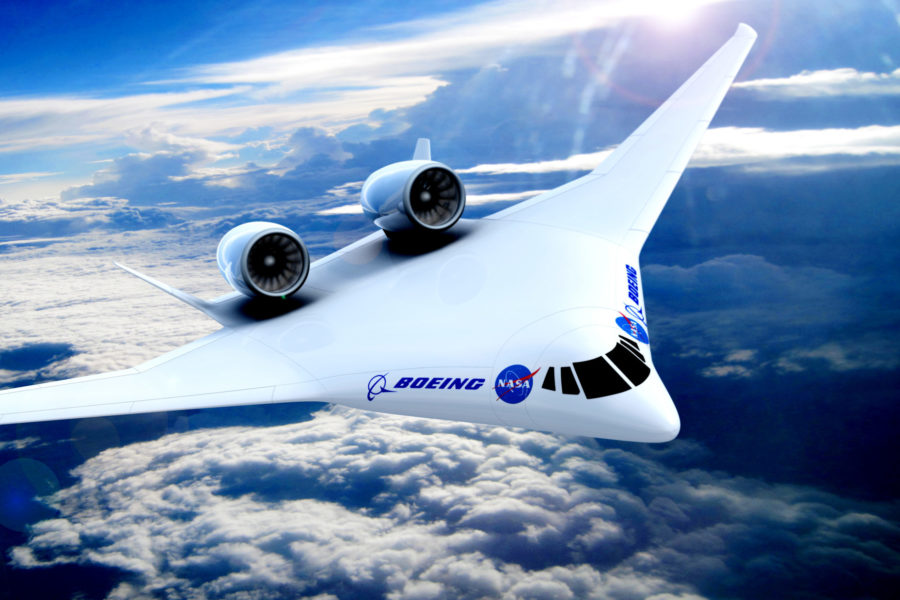The Air Force plans to complete testing of a full-scale blended wing body advanced cargo/tanker aircraft within four years, according to the department’s new Climate Action Plan. The demonstrator could be a prototype for a future operational mobility aircraft or family of aircraft, and the plan suggests the Air Force may skip the so-called “bridge tanker” acquisition.
The Air Force Climate Action Plan, released Oct. 5, notes a number of fuel-saving efficiency modifications for existing aircraft, such as winglets, vortex generators, compressor blade coatings, and more efficient engines. But one of its “Key Results” planned under fleet modernization is the development and testing “of a full-scale blended wing body prototype, completed by FY27.”
A blended wing body aircraft, as the name implies, is a large flying wing, dispensing with a cylinder-type fuselage and blending the wings directly into the fuselage. The concept, which is more aerodynamically efficient than a cylinder-type aircraft and boasts a far greater internal volume for fuel and payload, has been explored for decades. Boeing flew a subscale demonstrator called the X-48, in various configurations, from 2007 to 2013.
In the new, full-scale project, the Air Force is collaborating with the Defense Innovation Unit, NASA, and “industry partners” to “accelerate prototyping of ultra-efficient aircraft designs for future tanker and mobility aircraft,” the climate report said.
Such an aircraft “could drive transformative changes, as this aircraft design increases aerodynamic efficiency by at least 30 percent over current Air Force tanker and mobility aircraft and enables dramatically greater fuel offload at range to ensure strike capabilities in a contested environment,” according to the report.
Flying wing aircraft also tend to have an inherently lower radar cross-section than traditional configurations because of their shape and the lack of highly radar-reflective vertical stabilizers.
The Air Force was not immediately able to say what role the Air Force Research Laboratory would have in the project or whether the aircraft would have an “X-plane” designation like the X-48.
Energy-saving aircraft can increase payload range, decrease the need for additional tanker aircraft or forward-located refueling facilities, and “decrease risk to logistics supply chains,” all of which can “significantly improve combat capability,” the Air Force said.
In July, the Defense Innovation Unit put out a request for information for blended wing body aircraft concepts applicable to future tanker and cargo aircraft and potentially commercial aircraft as well. The RFI asked industry to pitch designs by Aug. 2 that could “provide at least 30 percent more aerodynamic efficiency than Boeing 767 and Airbus A330 families of commercial and military aircraft.”
The 767 is the basis of the KC-46 Pegasus tanker, and the A330 is the basis of the KC-30 Multi-Role Tanker Transport (MRTT), a variant of which Lockheed Martin has proposed—as the “LMXT”—to meet the Air Force’s so-called “bridge tanker” requirement. The aircraft would bridge the Air Force to a notional “KC-Z” stealthy tanker capable of operating and surviving in contested airspace, although in recent months the Air Force has discussed that aircraft as being much smaller than a traditional tanker.
The RFI touted blended wing aircraft as offering “operational advantages such as increased range, loiter time, and offload capabilities.”
Air Force Secretary Frank Kendall, beginning with the fiscal 2023 budget rollout, has warned the aviation industry that he believes that a modified version of the KC-46 will be the most likely solution to a “bridge tanker” requirement, but that more analysis has yet to be done.
Lockheed Martin has shown numerous variations on a blended wing body cargo/tanker aircraft at AFA’s annual Air, Space & Cyber conferences for many years.
The RFI said a blended wing body, coupled with the anticipated engine technology of 2030, could result in a “60 percent mission fuel burn reduction” versus current aircraft.
Companies responding to the DIU’s July solicitation were to submit a full plan to “design, develop, test, verify, validate and certify the system” for a potential “follow-on prototype build, live-fly, and production.” Potential contractors had to use digital methods for design and to create the aircraft using an open mission systems architecture for swift modifications and competitive equipment.
However, the RFI did not say what the timeframe would be for the possible blended wing body aircraft to fly. The climate report seems to have answered that question.
